

CODVIP rolling slots
2024-10-30 02:34 Views:192
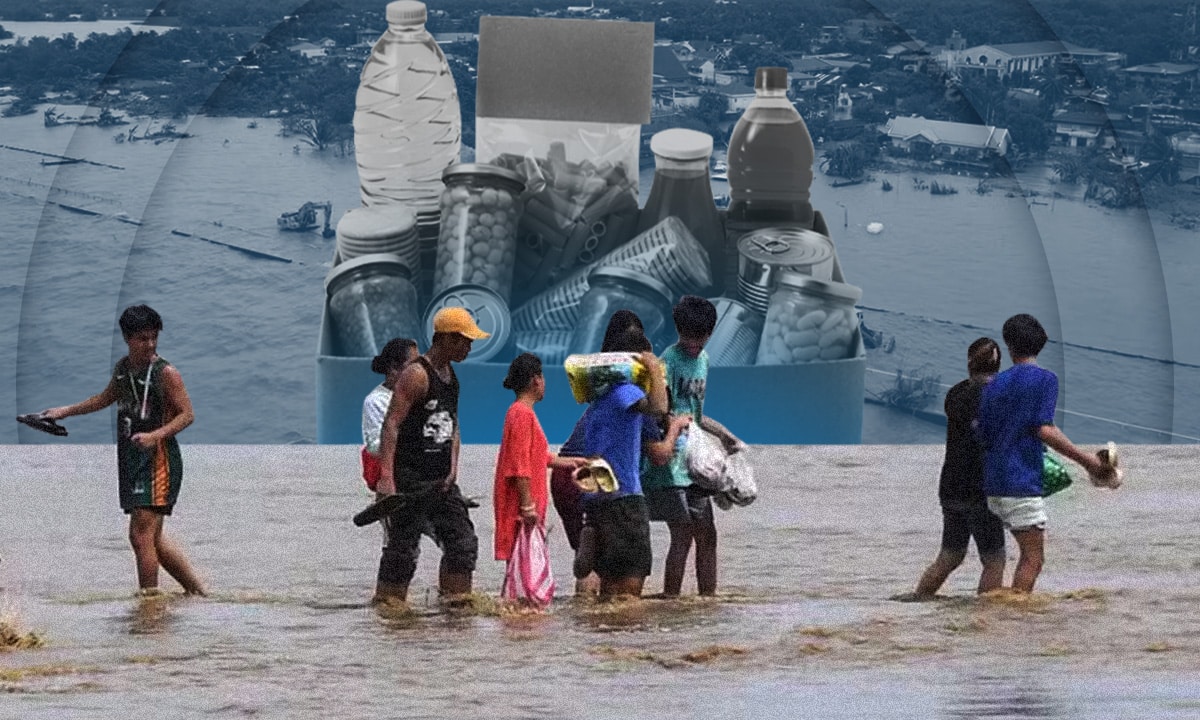

Keeping food safe after a flood composite image from AFP photos and INQUIRER stock
MANILA, Philippines—As the Philippines marks Food Safety Awareness Week, concerns are mounting over how to protect public health in the aftermath of Severe Tropical Storm Kristine.
Observed annually during the last week of October, Food Safety Awareness Week aims to raise public awareness and boost participation in government efforts to promote safe food practices. This observance was made official by Presidential Proclamation No. 160, signed in 1999 by then-President Joseph Estrada.
Article continues after this advertisementThis year’s focus on food safety takes on added urgency, as Tropical Storm Kristine has left parts of Luzon grappling with massive flooding, landslides, and widespread power outages.
FEATURED STORIES NEWSINFO Leon now a typhoon; 4 Luzon areas under Signal No. 2 NEWSINFO Pagasa 11 p.m. update: Signal No. 5 possible over Batanes, Babuyan Is. NEWSINFO Leon may become super typhoon Disasters, calamities impact food safetyThe International Food Safety Authorities Network (INFOSAN), a global network of 186 national food safety authorities managed jointly by the Food and Agriculture Organization (FAO) and the World Health Organization (WHO), said food safety is a critical public health concern often overlooked during disasters.
“During or following natural disasters […] food in affected areas may become contaminated with dangerous microbiological and chemical agents. Consequently, those populations are at risk for outbreaks of food-borne diseases, including hepatitis A, typhoid fever, and diarrhoeal diseases, such as cholera and dysentery,” INFOSAN stressed.
Article continues after this advertisement“In particular, floods are often followed by a general increase of diarrhoeal diseases but rarely by specific outbreaks,” the network added.
Article continues after this advertisementREAD: Food safety: How not to die or get sick while eating99bet
Article continues after this advertisement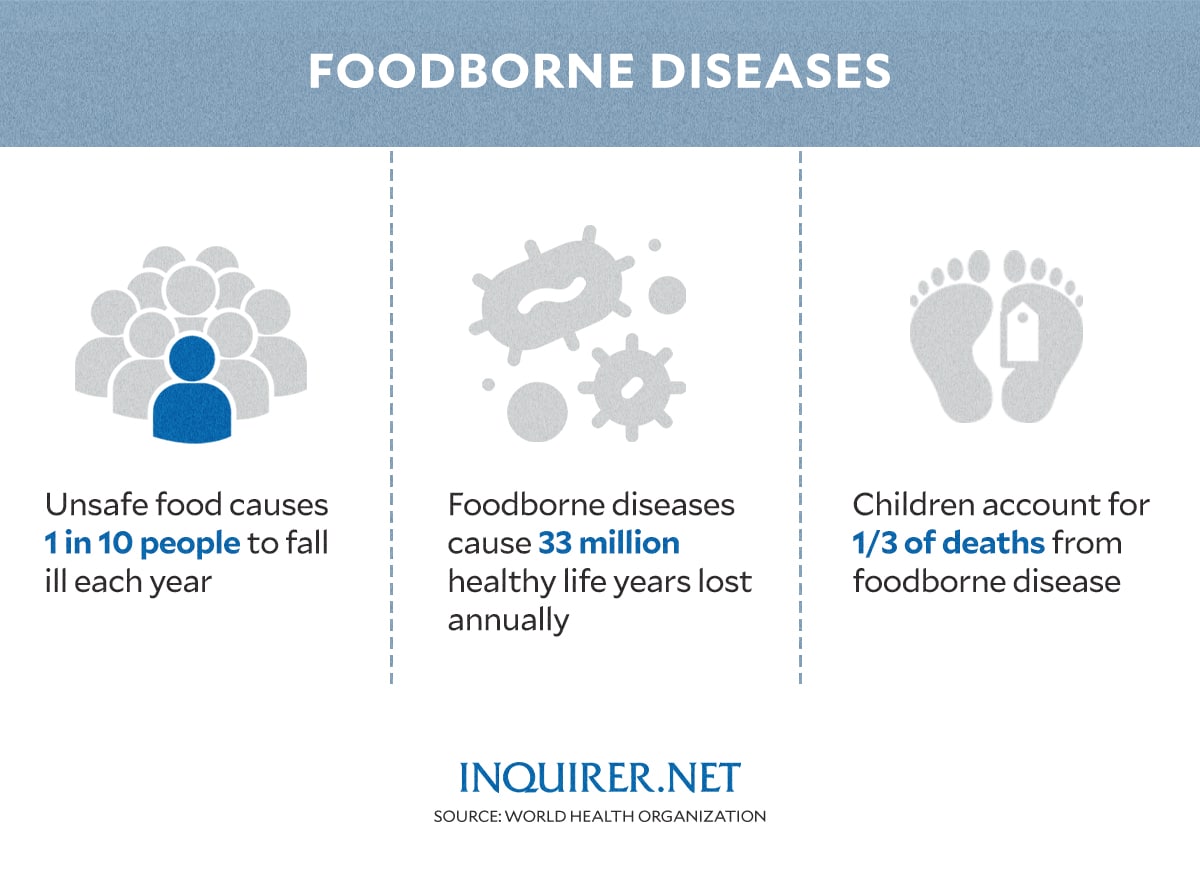

GRAPHIC: Ed Lustan
In the Philippines — situated along the typhoon belt and the Pacific Ring of Fire — disasters such as typhoons, flooding, landslides, earthquakes, and volcanic eruptions pose significant threats to both food safety and public health.
“[N]atural disasters such as typhoons and floods may lead to secondary public health crises from disease outbreaks like acute infectious diarrhea,” said Dr. Ian Christopher Rocha, Dr. Kimberly Ramos, and Kevin Crispino in an article published in the peer-reviewed health and medical journal Prehospital and Disaster Medicine.
Article continues after this advertisement“This amplifies the socioeconomic damages brought by the public health emergency and creates further morbidity and mortality,” they added.
Outbreaks in PH after disastersOne incident of food and waterborne disease outbreaks, such as diarrhea and gastroenteritis following a disaster, was reported when Super Typhoon Odette (Rai) battered areas in the Visayas and Mindanao and some parts of southern Luzon in 2021.
READ: Year’s strongest typhoon dumped more rain than ‘Yolanda’
The Department of Health (DOH) reported 80 cases of gastroenteritis at a hospital in Dinagat Islands and 54 cases of diarrhea in Siargao Island, both of which were severely affected by Odette.
“The imminent outbreak is due to contamination of water in these areas as a result of damaged water pipes and water supply outage, as well as food contamination due to poor sanitation and unsafe food storage, handling, and preparation,” explained Rocha and his co-authors.
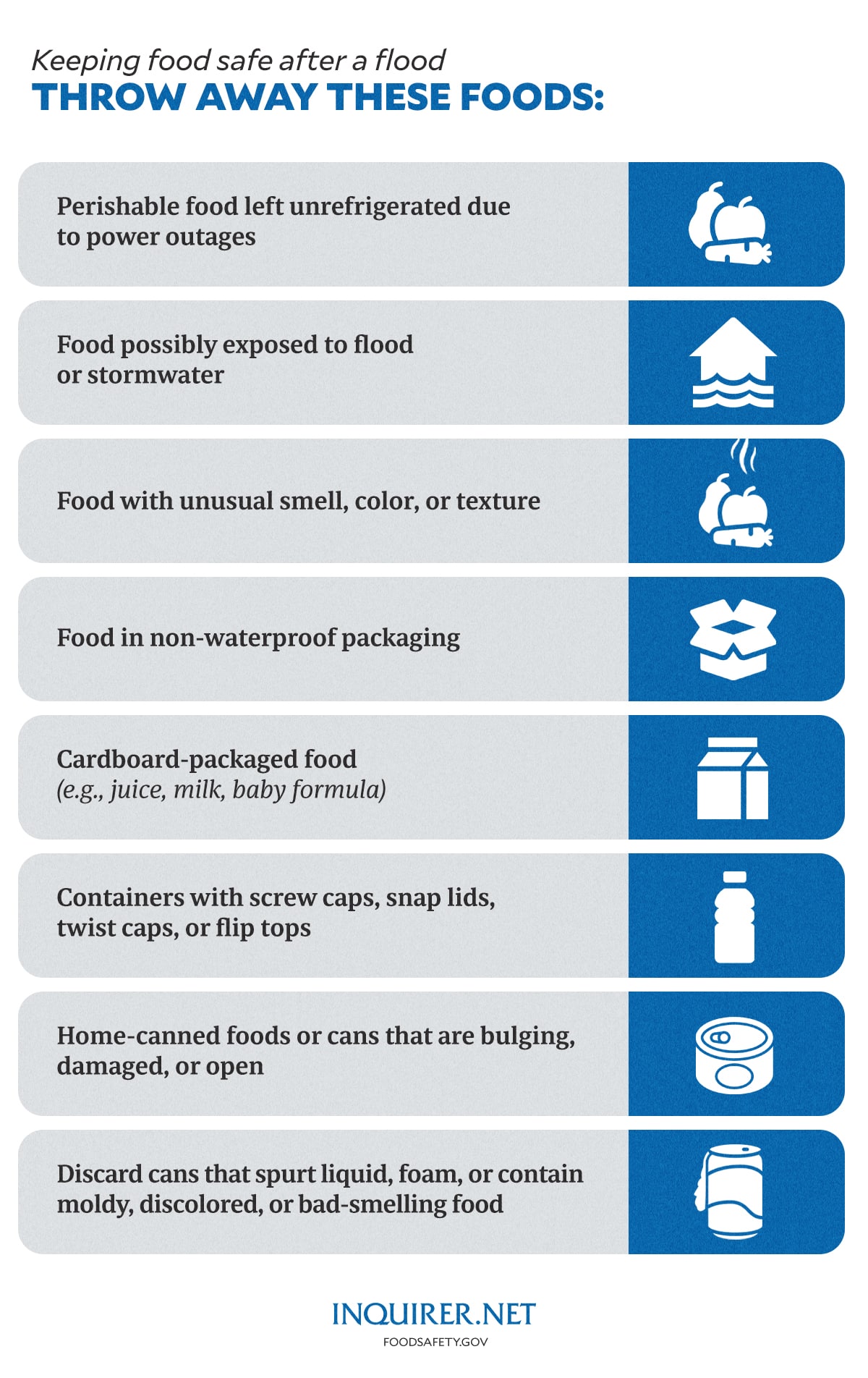

GRAPHIC: Ed Lustan
Earlier this year, another incident occurred when 216 residents from the isolated village of Tandang Sora in Esperanza town were rushed to different hospitals after experiencing vomiting, stomach pains, and diarrhea.
READ: Food poisoning downs 216 flood survivors in Agusan del Sur town
The patients, who were also flood victims, reportedly fell ill after consuming food packs distributed to those affected by the flooding. Authorities considered food poisoning as a possible cause of the residents’ symptoms.
READ: All Agusan del Sur food poosoning victims discharged from hospital
“Food safety risks are mainly linked to unsafe food storage, handling, and preparation. In many cases, cooking may be impossible during natural disasters due to the lack of facilities or fuel,” INFOSAN said.
“Poor sanitation, including a lack of safe water and toilet facilities, can compound the risks,” they added.
Food safety during a disasterData from WHO showed that an estimated 600 million people fall ill and 420,000 people die from unsafe food each year. Children under 5 years of age are at particularly high risk, with 125,000 children dying from food-borne diseases every year.
However, food and waterborne illnesses and deaths are largely preventable.
“As persons suffering from the direct effects of the disaster may already be at risk through malnutrition, exposure, shock, and other traumas, it becomes essential that the food they consume is safe,” INFOSAN stressed.
According to the US Centers for Disease Control and Prevention (CDC), there are steps to take to prevent illness from unsafe food during a disaster. Some of it begins with preparing before a disaster or emergency hits.
Since disasters can disrupt the food and clean water supply, authorities suggest having at least a 3-day supply of food on hand, including those that:
Have a long shelf life. Require little or no cooking, water, or refrigeration. Meet the dietary needs of infants, special diets, and pets. Are low in salt and spice to minimize water intake.To properly store emergency food supplies, the US Department of Health & Human Services gave the following tips:
Check expiration dates on canned and dry foods; home-canned goods should be discarded after a year. Store food in a cool, dry, dark place (ideal temperature: 40°F to 70°F or 4.44°C to 21.11°C). Keep food away from heat sources and petroleum products. Use airtight, waterproof containers to protect against pests and flooding.It is also important to store at least one gallon of water per person and pet per day, maintaining a minimum three-day supply in a flood-safe area. Additionally, stored water should be replaced every six months.
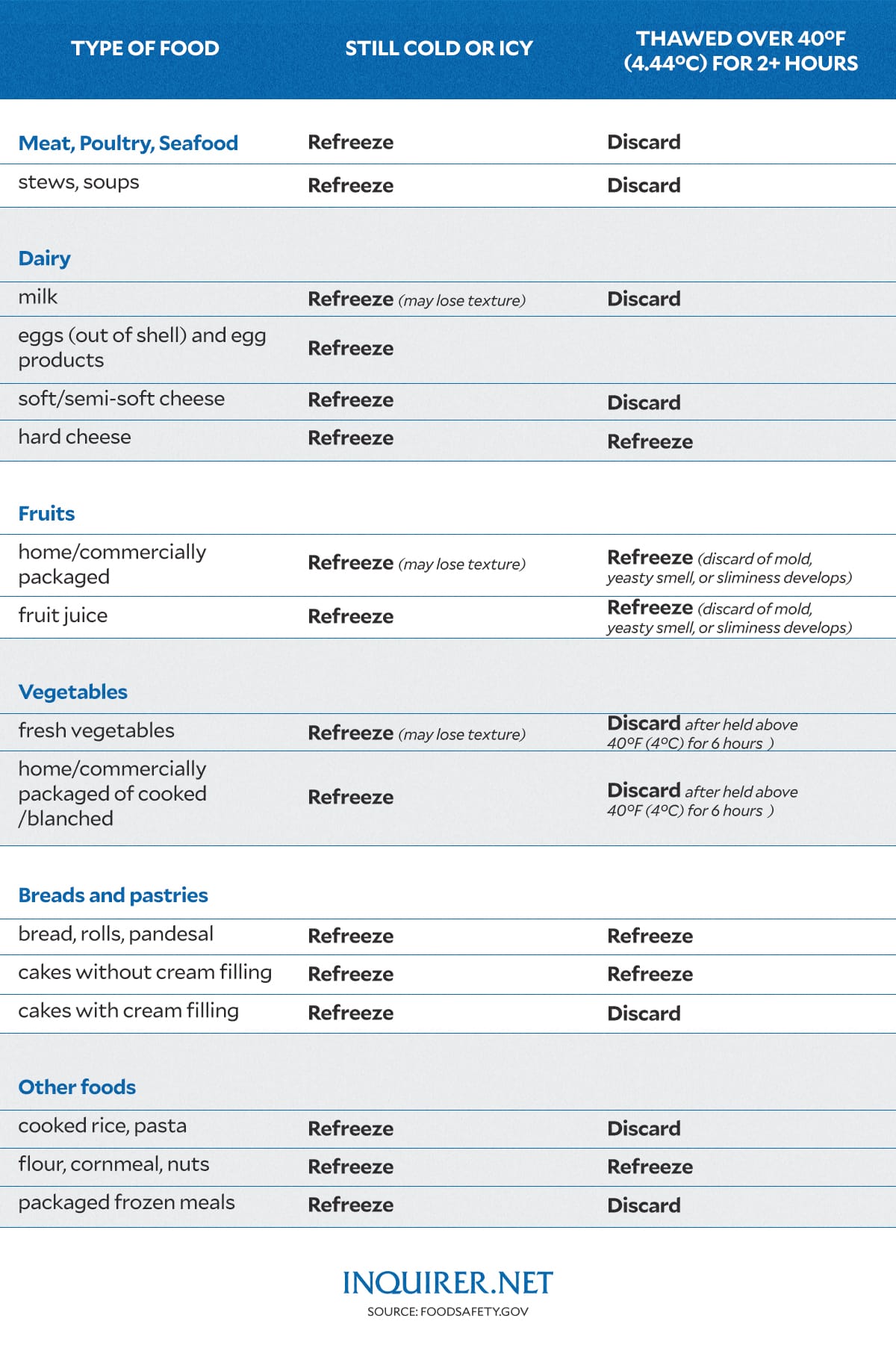

GRAPHIC: Ed Lustan
Aside from preparing food and water supplies, the public is also told to prepare for a power outage during disasters and emergencies. Some ways to be prepared include:
Using freeze gel packs, ice cubes, and containers of water to keep food cold. Freezing perishable items like leftovers and fresh meats to extend their safe storage time. Grouping food together in the freezer and have coolers ready for extended outages. Purchasing dry ice and block ice, in case it should be needed.If the power goes out during a disaster, standard refrigerator will keep food cold for about four hours if left unopened. In contrast, a fully stocked freezer can maintain its temperature for approximately 48 hours (or 24 hours if it is half full) as long as the door remains closed.
“If you plan to eat refrigerated or frozen meat, poultry, fish, or eggs while they are still at safe temperatures, it is important that each item is thoroughly cooked to a safe minimum internal temperature to ensure that any food-borne bacteria that may be present are destroyed,” said the US Department of Health & Human Services.
“However, if at any point the food was above 40°F (4°C) for 2 hours or more (or 1 hour if temperatures are above 90°F (32°C )) — discard it,” it added.
What to do after a disasterAs a general rule, it is advised to throw away the following food after a disaster or emergency:
Perishable food that has not been refrigerated or frozen properly due to power outages. Food that may have come in contact with floodwater or stormwater. Food with an unusual odor, color, or texture.Aside from those, people are also advised not to consume any food that may have come into contact with flood or stormwater. The following items should be discarded:
Cardboard-packaged food (e.g., juice, milk, baby formula). Containers with screw caps, snap lids, twist caps, or flip tops. Home-canned foods or cans that are bulging, damaged, or open. Cans that spurt liquid, foam, or contain moldy, discolored, or bad-smelling food.Following a power outage, people must never taste food to know if it is safe. “When in doubt, throw it out,” said the CDC.
Perishable food in your refrigerator — such as meat, fish, cut fruits and vegetables, eggs, milk, and leftovers — should be thrown out after four hours without power or a cold source like ice.
Thawed frozen food can still be safely refrozen or cooked as long as it still contains ice crystals or is at 40°F (4°C) or below.
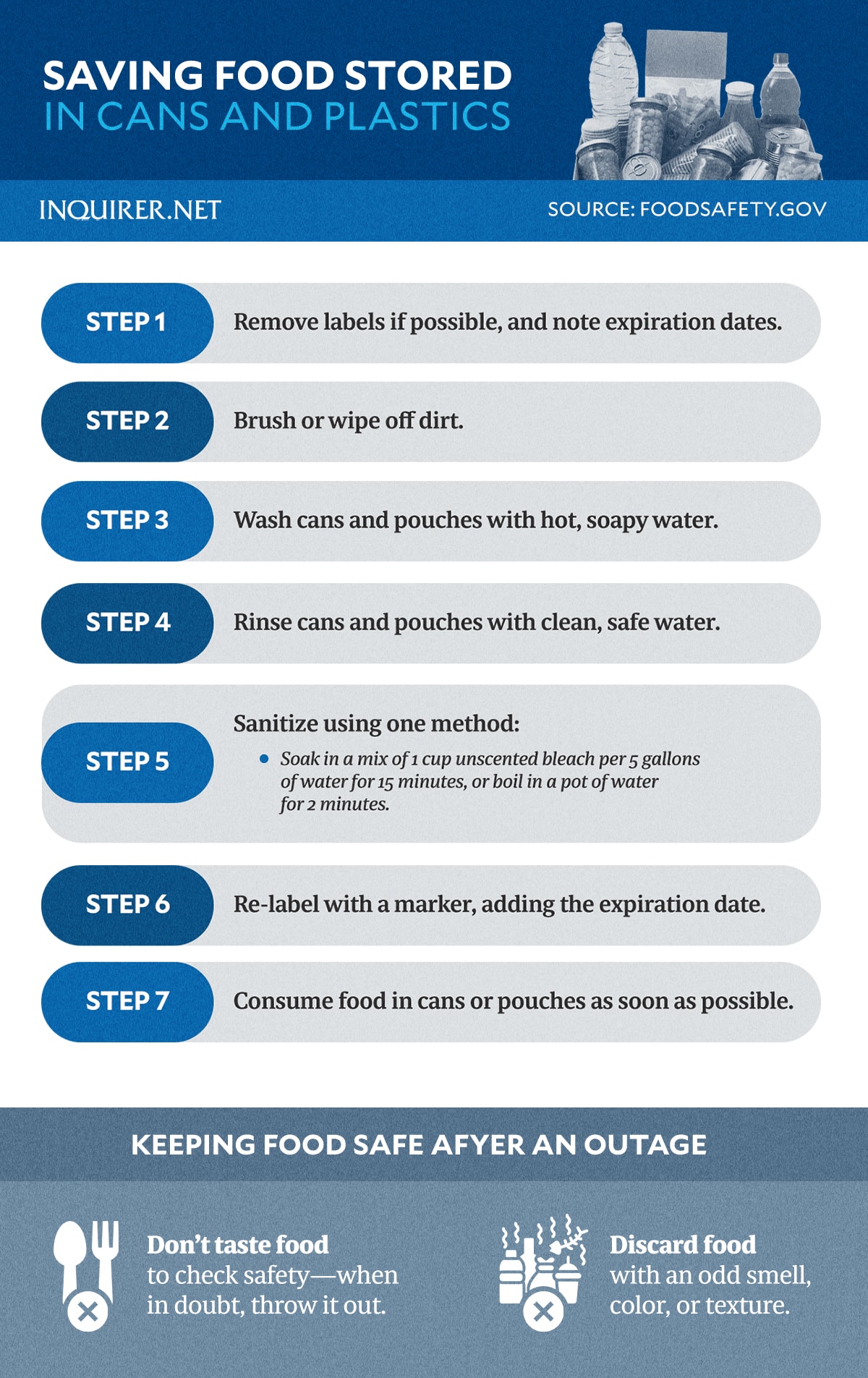

GRAPHIC: Ed Lustan
Although it is essential to discard food after an extended outage and flooding as a food safety precaution, there are ways to salvage commercially prepared foods in cans and flexible plastic or metal pouches (such as shelf-stable juice packages):
Step 1: Remove labels if possible, and note expiration dates.
Step 2: Brush or wipe off any dirt.
Step 3: Wash cans and pouches with hot, soapy water.
Step 4: Rinse cans and pouches with clean, safe water.
Step 5: Sanitize using one method:
Soak in a mix of 1 cup unscented bleach per 5 gallons of water for 15 minutes, or Boil in a pot of water for 2 minutes.Step 6: Re-label with a marker, adding the expiration date.
Step 7: Consume food in cans or pouches as soon as possible.
It is also crucial to discard wooden cutting boards, baby bottle nipples, and pacifiers that have come into contact with floodwaters, as sanitizing methods cannot effectively remove contaminants.
For dishes, utensils, and surfaces that touch food, follow this four-step cleaning and sanitizing process:
Step 1: Clean with hot, soapy water.
Step 2: Use clean, safe water.
Step 3: Prepare a solution of 1 cup (8 oz/240 mL) of unscented household chlorine bleach in 5 gallons of clean water. Soak items for 1 minute, ensuring they are fully submerged. For non-soakable items like countertops, apply the solution with a cloth.
Step 4: Allow items to air dry completely.
Related stories:
FAO warning: Climate change poisons food
Food safety is everybody’s responsibility
Subscribe to our daily newsletter
Food safety: How not to die or get sick while eating
READ NEXT BCDA gets new chairperson: Hilario Paredes Lacson thinks ex-President Duterte ‘invaded’ Senat... EDITORS' PICK House members hit leeway given to Bato, Go in Senate hearing SC issues TRO vs transfer of PhilHealth funds to National Treasury LIVE UPDATES: Typhoon Leon PNP cites huge drop in crime under Marcos Marcos wants flexible payment options on electricity bills Groups welcome SC TRO on PhilHealth fund transfer MOST READ 15% of ballot shading eyed LIVE UPDATES: Typhoon Leon Senate urged to send Duterte ‘confession’ to ICC House members hit leeway given to Bato, Go in Senate hearing Follow @FMangosingINQ on Twitter --> View comments